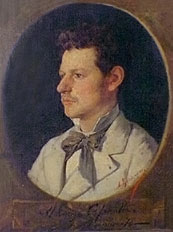Son of Italian immigrants, Francisco Cafferata was born in Buenos Aires, on February 28, 1861, at the corner of Pedro de Mendoza and Martín Rodríguez streets, in La Boca. He gets his first art training from Julio Laguens.
With his family’s financial support, he sets off to Italy in 1877 to study sculpturing. His maestros are: Urbano Lucchesi and Augusto Passaglia. In 1882, Cafferata sends El esclavo (The slave) to Buenos Aires, a piece that gets the First Prize and Gold Medal at the Exposición Continental. Today, it can be found at the Palermo Park, in Palermo.
He remains in Florence until 1885. That year, he returns to Argentina bringing among other sculptures, the monument of Admiral Guilllermo Brown that had received the best critics and comments in Italy, and which is considered equally well by the local press. It will be placed at the Adrogué Park in 1886. This would become the first public monument made by an Argentine artist. José León Pagano observes that making statues drives him to make portraits and iconographies derived from historical figures such as Bartolomé Mitre, Mariano Moreno, Bernandino Rivadavia and Manuel Belgrano. This last one was made in two opportunities for the provinces of Salta and Tucumán, respectively.
Among his most outstanding work, other than the ones already mentioned, we find: La niñez del Giotto (Giotto´s childhood) and Cabeza de esclavo (Head of a slave), both at the Museo Nacional de Bellas Artes and Cabeza de mulato (Head of a mulato), a bronze piece at the Museo Castagnino in Rosario, where the naturalism of his maestros from Florence stand out over the neoclassical tradition.
Apart from the mentioned institutions, his work can also be found at the following museums: Histórico Nacional, Bellas Artes de La Boca “Benito Quinquela Martín” and Provincial de Bellas Artes in Mendoza.
Cafferata takes his own life on November 28, 1890, a few months before turning 30 years old, while he was working on a monument dedicated to Falucho, which would be finished with some modifications, by Lucio Correa Morales.
